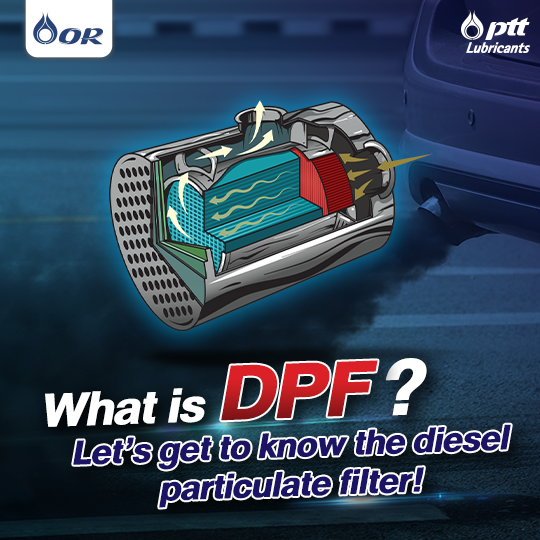What is a DPF? Let’s get to know the diesel particulate filter!
What is a DPF? What does it have to do with the car exhaust? Anyone who doesn't use a diesel engine car might be a little confused if they are asked this question. However, for those who use diesel vehicles, you are probably familiar with the term DPF, but may not understand what it does. Today, let PTT Lubricants explain to you about how this device actually works!
DPF stands for Diesel Particulate Filter or diesel exhaust particulate filter. The inside of the filter is a small honeycomb shape box that operates by trapping small soot particles (Particulate Matter) in the exhaust of diesel vehicles. Due to today's increasingly stringent exhaust emissions control measures to reduce the problem of air pollution and PM 2.5, for example, the reduction in maximum quantity and amount of exhaust particulate matter to be emitted by car of the Euro 5 emission standard, diesel vehicles of Euro 5 standard and above, therefore, need to be equipped with a DPF device to trap exhaust particulate matter before being released to the outside.
Currently, many diesel cars in Thailand have started using engines of Euro 5 and Euro 6 standards. Many of those, however, might have encountered engine vibration, noise problems, sluggish acceleration, oil pressure drop or the blipping of oil pan light and the DPF light on the dashboard so often that they are too afraid to continue driving.
These problems can arise after the car has been driven for a while since the DPF becomes clogged as the amount of soot being filtered increases and accumulates. A normal DPF device will have a filtered exhaust pressure monitoring sensor, and if the pressure difference is higher (Pressure Drop), that means the DPF filter has become more clogged.
The process of removing clogging soot is called ‘Regeneration’ and is performed by using heat from the exhaust gas or flame to dissolve the soot into smaller particles. Such processes usually occur automatically when driving long distances at a certain speed where the heat and exhaust temperatures are high enough to burn soot. However, if the car is mainly driven in the city, the exhaust temperature may not be high enough to dissolve soot.
Therefore, in order to prevent damage to the DPF and the engine, it is important to observe the status of the DPF device. When a certain amount of soot has accumulated, a warning light will display showing the DPF symbol on the dashboard. That is when the regeneration should be checked as specified in the manual.
DPF is actually a device that reduces air pollution and PM dust in the air and is contributing to a better environment for our environment. It is important that the condition must always be kept in check so that it can work at its full efficiency while also prolonging the service life.
It is recommended to choose to refuel with Euro 5 standard diesel fuel with a sulfur content not exceeding 10 ppm, as well as choose medium ash or low ash engine oil according to the standard specified in the vehicle manual. An improper selection will affect clogging of the DPF equipment and can result in engine performance deterioration as well as faster damage by the ash from the burning fuel and some volatile engine oil. Since the ash clogged in the DPF cannot be eliminated by the regeneration process, it adversely affects the functioning of the DPF and may even have to replace the DPF.
Lastly, regardless of whether your car's engine is equipped with DPF or not, PTT Lubricants have the right engine oil for both diesel engines with and without DPF for you to choose the right one and be confident in every ride until you have arrived. No more stumbling on the road!
Read more about engine oil from PTT Lubricants for engine equipped with DPF: https://pttlubricants.pttor.com/product_detail/1/2/19
Engine oils from PTT Lubricants are now available at PTT Station and FIT Autio or any store that carries PTT Lubricants near you!
